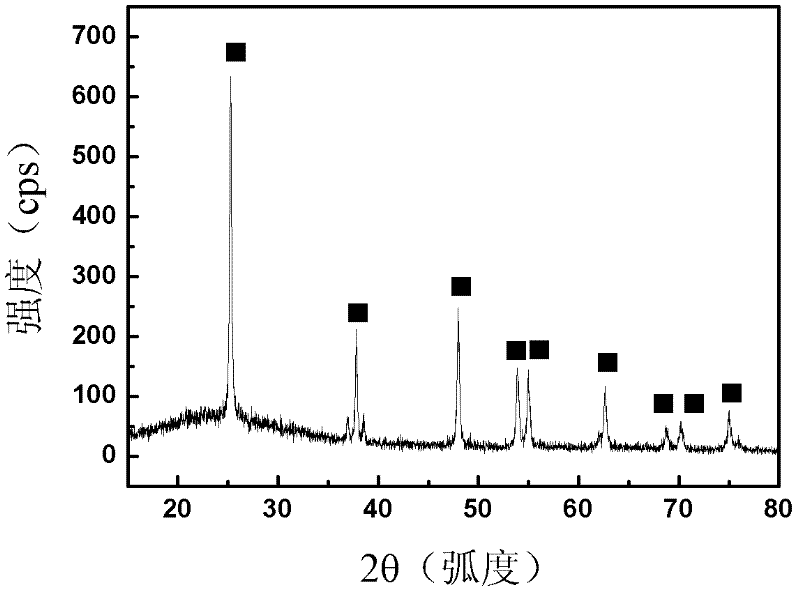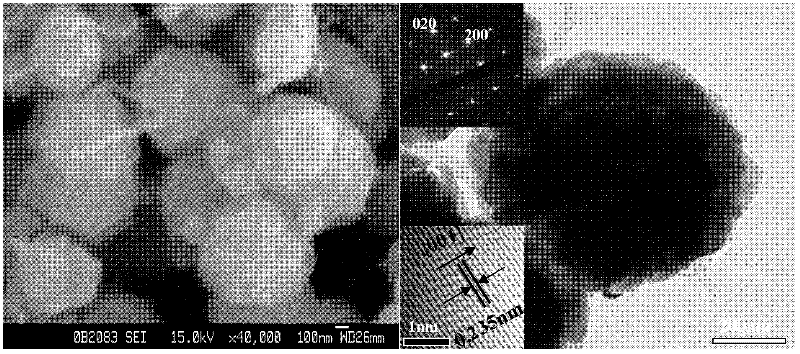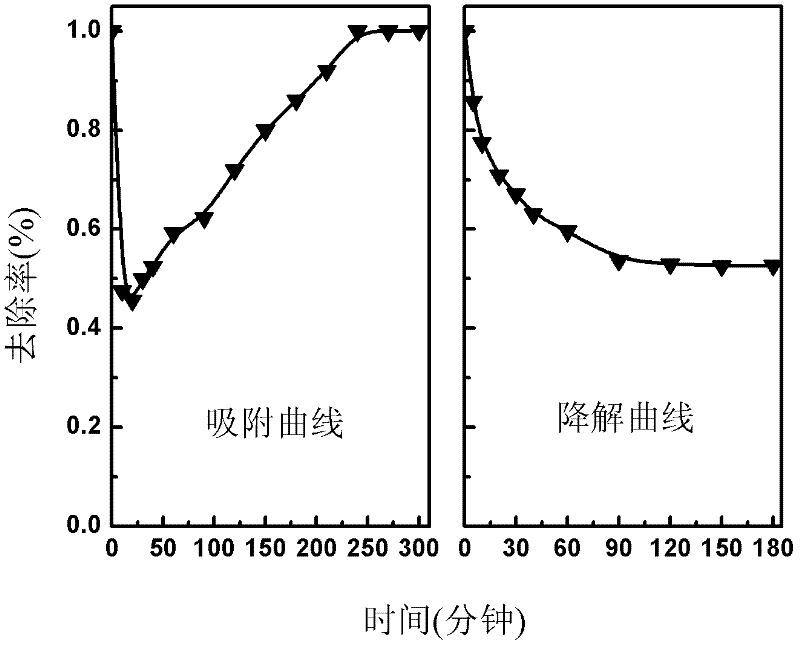Carbon nanotube and {001}surface TiO2 microsphere composite material photocatalyst
A carbon nanotube, composite material technology, applied in physical/chemical process catalysts, other chemical processes, chemical instruments and methods, etc., can solve the problems of reducing the total removal efficiency of photocatalytic degradation rate, low specific surface area, application limitations, etc. Achieve the effect of broad environmental protection application potential
- Summary
- Abstract
- Description
- Claims
- Application Information
AI Technical Summary
Problems solved by technology
Method used
Image
Examples
Embodiment 1
[0028] (1) Add 0.5 g of multi-walled carbon nanotubes to 40 mL of concentrated hydrochloric acid and concentrated nitric acid with a volume ratio of 2:1, reflux at 100 ° C for 120 minutes, then filter and wash until the pH of the washing solution is 6, and The washed precipitate was dried at 100°C to obtain purified multi-walled carbon nanotubes;
[0029] (2) 0.05g of titanium tetrafluoride was added to 30mL of water, and fully stirred for 10 minutes to obtain a clear solution of titanium tetrafluoride;
[0030] (3) Add 0.2 g of the purified multi-walled carbon nanotubes obtained in step (1) to 20 mL of the titanium tetrafluoride clarified solution obtained in step (2), and ultrasonically disperse for 5 minutes to obtain a mixed solution;
[0031] (4) Put 10 mL of the mixed solution obtained in step (3) into a polytetrafluoroethylene tank, and conduct a hydrothermal reaction at 150° C. for 52 hours;
[0032] (5) After the solution in the tank is cooled, collect the sediment a...
Embodiment 2
[0042] (1) 0.5g double-walled carbon nanotubes are added to 60mL of concentrated hydrochloric acid and concentrated sulfuric acid with a volume ratio of 1:1, refluxed at 60°C for 180 minutes, then filtered and washed until the pH of the washing solution is 5, and the The washed precipitate was dried at 50°C to obtain purified double-walled carbon nanotubes;
[0043] (2) 0.01g of titanium tetrafluoride was added to 200mL of water, and fully stirred for 60 minutes to obtain a clear solution of titanium tetrafluoride;
[0044] (3) Add 1 g of the purified double-walled carbon nanotubes obtained in step (1) to 100 mL of the titanium tetrafluoride clarified solution obtained in step (2), and obtain a mixed solution after ultrasonic dispersion for 10 minutes;
[0045] (4) Put 10 mL of the mixed solution obtained in step (3) into a polytetrafluoroethylene tank, and conduct a hydrothermal reaction at 250° C. for 2 hours;
[0046] (5) After the solution in the tank is cooled, collect t...
Embodiment 3
[0048] (1) Add 2g of multi-walled carbon nanotubes to 100mL of concentrated hydrochloric acid and concentrated nitric acid with a volume ratio of 4:1, reflux at 80°C for 80 minutes, then filter and wash with water until the pH of the washing solution is 11, wash with water The final precipitate was dried at 80°C to obtain purified multi-walled carbon nanotubes;
[0049] (2) 0.08g of titanium tetrafluoride was added to 60mL of water, fully stirred for 6 minutes to obtain a clear solution of titanium tetrafluoride;
[0050] (3) Add 0.15 g of purified multi-walled carbon nanotubes obtained in step (1) to 45 mL of the titanium tetrafluoride clarified solution obtained in step (2), and obtain a mixed solution after ultrasonic dispersion for 12 minutes;
[0051] (4) Put 5 mL of the mixed solution obtained in step (3) into a polytetrafluoroethylene tank, and conduct a hydrothermal reaction at 120° C. for 42 hours;
[0052] (5) After the solution in the tank is cooled, collect the se...
PUM
| Property | Measurement | Unit |
|---|---|---|
| Diameter | aaaaa | aaaaa |
Abstract
Description
Claims
Application Information
 Login to View More
Login to View More - R&D
- Intellectual Property
- Life Sciences
- Materials
- Tech Scout
- Unparalleled Data Quality
- Higher Quality Content
- 60% Fewer Hallucinations
Browse by: Latest US Patents, China's latest patents, Technical Efficacy Thesaurus, Application Domain, Technology Topic, Popular Technical Reports.
© 2025 PatSnap. All rights reserved.Legal|Privacy policy|Modern Slavery Act Transparency Statement|Sitemap|About US| Contact US: help@patsnap.com



